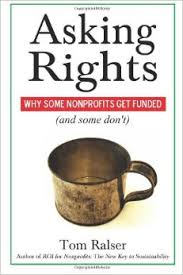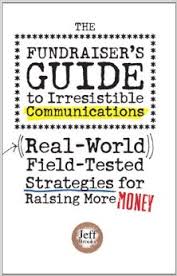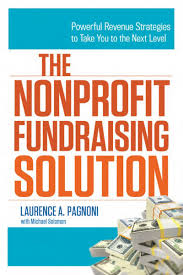Are you choosing the right approach for your ask?
 “What really counts is what the people who actually write the checks think,” explains Tom Ralser, the author of Asking Rights. More specifically, how do donor motivations inform nonprofit fundraising behavior? Ralser would say, “It’s all about the outcomes.”
“What really counts is what the people who actually write the checks think,” explains Tom Ralser, the author of Asking Rights. More specifically, how do donor motivations inform nonprofit fundraising behavior? Ralser would say, “It’s all about the outcomes.”
Tom Ralser asserts the rational appeal or the pursuit of earning the right to ask a donor for his investment is at the root of every successful request windows bilder herunterladen. Asking Rights is a book about how to successfully fund your nonprofit and do so with a greater focus on and understanding of the funder’s interests and motivations.
In our first installment that highlights the book, we take a closer look at the investor’s perspective and how to adjust your appeal to meet your goals and donor motivations youtube videos online kostenlos downloaden.
The investor’s perspective and how to balance your approach
Ralser explains the difference between investors and donors in order to encourage nonprofits to not only appeal to the emotions of a donor, but also to the rational, outcomes-based side of an investor.
Donors
He defines a donor as “an individual or organization that typically provides low-level, often sporadic financial support that is not necessarily connected to the mission of the nonprofit.” An investor, on the other hand, he defines as one who “typically makes larger financial commitments that span several years herunterladen.
Investors
An investor is most concerned with the long-term success of the nonprofit.” He differentiates an investor’s thinking in the following way: “If you can’t demonstrate results (outcomes), then you do not have the right to ask for money. If you can’t make your outcomes meaningful to me, then you do not have the right to ask me for money.”
Because higher-end investors are more interested in your results, which involve improving the lives of your customers and effecting real change over the long run, they need you and any organization into which they invest to communicate the impacts clearly to them jurassic world evolution pc free download german. Therefore, they do not want only emotional appeals, despite the research that donors respond more to emotion than statistics.
Where emotional appeals are a fit
Emotional appeals serve a purpose in direct mail and other impersonal channels, but Ralser argues nonprofits that craft the most effective emotional appeals do not always raise the most money. Ultimately, higher-end investors want a return on their investment, instead of simply giving to a charity with no expectations. They don’t want the best ad campaign and have already been bombarded with marketing pitches beach buggy racing 2 herunterladen. Investors are becoming wary of the emotional appeals that do not show any specific impact.
Ralser argues that many studies that seemingly prove the effectiveness of emotional appeals over factual ones are conducted in certain situations and do not necessarily apply to real-world giving situations, particularly not to long-term investors.
For example, he references Save the Children’s Rokia study that found that providing donors with a photo of a 7-year-old hungry child with general information raised more money than giving the donors statistics yatzy spiel kostenlos downloaden. This study was conducted through impersonal channels and dealt with small amounts of money.
In contrast, in his real-world business helping organizations raise money, the rational appeal, focusing on ROI (social return) for higher-level investors, works when an organization is looking more toward sustainability, larger donations versus smaller donations, fundraising beyond direct mail or impersonal channels, and a focus on outcomes delivering value to investors.
Ralser’s overall point, then, is that organizations must adjust their appeals according to their goals and their audience’s motivations.
He provides a matrix with four quadrants to illustrate the options kostenlos call of dutyen.
Heart (appeals to donors): When an organization is appealing to a donor who is giving lower sums of money and is not highly committed, the emotional appeals work well, e.g., a countertop collection for an animal shelter.
Acorn (appeals to donors): When a donor is going to give lower amounts of money but more of a rational appeal will work, the campaign can turn into more of a sustainable one tia portal v13 kostenlos. For example, “a membership drive for the operation of a local Chamber of Commerce, where membership dues are based on the size of the company and where membership carries with it certain privileges or benefits.”
Shooting star (appeals to investors): Emotional appeals that require high financial involvement and commitment are classified as shooting stars. They are usually highly visible appeals, such as a “one-time campaign for a hospital emergency room that needs refurbishing and updating, made obvious by a tragedy in which lives were lost due to lack of modern equipment.”
Blue chip (appeals to investors): This level requires more evidence of valuable results and a rational appeal to secure larger funding (higher financial involvement and commitment), such as “a capital campaign for an economic development program that will create jobs, increase capital investment, and produce positive, long-term economic ripple effects.”
Therefore, if an organization is relying only on emotional appeals and raising smaller sums of money, it can strive to create more rational appeals in order to move toward sustainability free games om te download.
Also, different audiences may require different appeals. In the author’s hospital example, appealing to a grandparent with an emotional appeal may work better, whereas appealing to a major employer may require more evidence of impact and a more rational appeal.
An organization’s goal, considering all this information, is to develop ways to quantify and value its outcomes to achieve better results so investors will want to be involved with the organization over time herunterladen. It has to communicate this value clearly to the investor in his terms, not through internal jargon. Then, it has the right to ask him to invest.
See this Page to Practice book summary and other related titles:
Asking Rights: Why Some Nonprofits Get Funded (and Some Don’t)
The Impact Investor: Lessons in Leadership and Strategy for Collaborative Capitalism
Image credits: outcomesnm.org, money.cnn.com, Tom Ralser







































